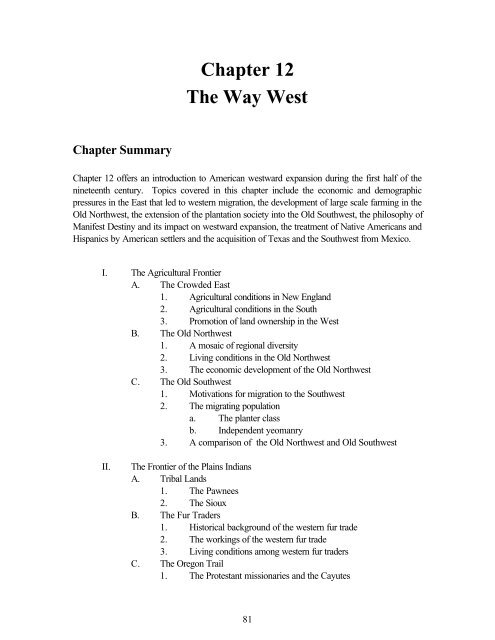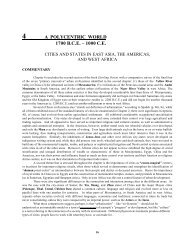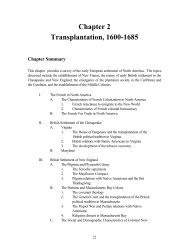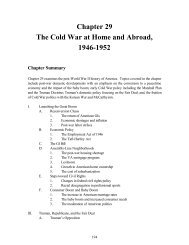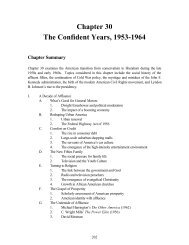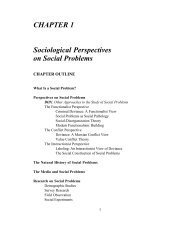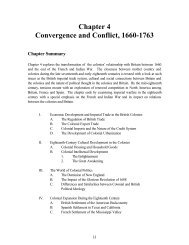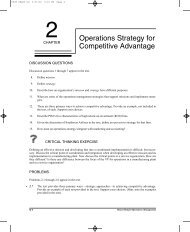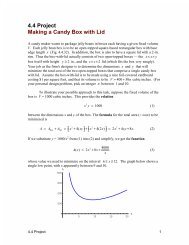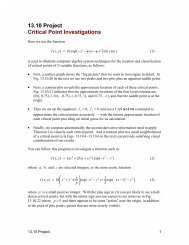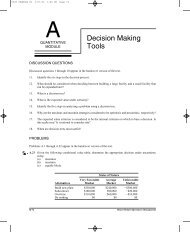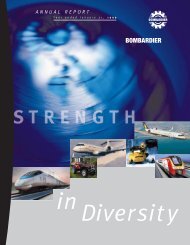Chapter 12 The Way West
Chapter 12 The Way West
Chapter 12 The Way West
You also want an ePaper? Increase the reach of your titles
YUMPU automatically turns print PDFs into web optimized ePapers that Google loves.
<strong>Chapter</strong> Summary<br />
<strong>Chapter</strong> <strong>12</strong><br />
<strong>The</strong> <strong>Way</strong> <strong>West</strong><br />
<strong>Chapter</strong> <strong>12</strong> offers an introduction to American westward expansion during the first half of the<br />
nineteenth century. Topics covered in this chapter include the economic and demographic<br />
pressures in the East that led to western migration, the development of large scale farming in the<br />
Old Northwest, the extension of the plantation society into the Old Southwest, the philosophy of<br />
Manifest Destiny and its impact on westward expansion, the treatment of Native Americans and<br />
Hispanics by American settlers and the acquisition of Texas and the Southwest from Mexico.<br />
I. <strong>The</strong> Agricultural Frontier<br />
A. <strong>The</strong> Crowded East<br />
1. Agricultural conditions in New England<br />
2. Agricultural conditions in the South<br />
3. Promotion of land ownership in the <strong>West</strong><br />
B. <strong>The</strong> Old Northwest<br />
1. A mosaic of regional diversity<br />
2. Living conditions in the Old Northwest<br />
3. <strong>The</strong> economic development of the Old Northwest<br />
C. <strong>The</strong> Old Southwest<br />
1. Motivations for migration to the Southwest<br />
2. <strong>The</strong> migrating population<br />
a. <strong>The</strong> planter class<br />
b. Independent yeomanry<br />
3. A comparison of the Old Northwest and Old Southwest<br />
II. <strong>The</strong> Frontier of the Plains Indians<br />
A. Tribal Lands<br />
1. <strong>The</strong> Pawnees<br />
2. <strong>The</strong> Sioux<br />
B. <strong>The</strong> Fur Traders<br />
1. Historical background of the western fur trade<br />
2. <strong>The</strong> workings of the western fur trade<br />
3. Living conditions among western fur traders<br />
C. <strong>The</strong> Oregon Trail<br />
1. <strong>The</strong> Protestant missionaries and the Cayutes<br />
81
2. <strong>The</strong> overlanders and women on the trail<br />
3. Living conditions on the Oregon Trail<br />
4. <strong>The</strong> impact of western migration on the Great Plains<br />
5. <strong>The</strong> struggle between the Sioux and the United States<br />
government over claims in the Great Plains<br />
III. <strong>The</strong> Mexican Borderlands<br />
A. <strong>The</strong> Peoples of the Southwest<br />
1. <strong>The</strong> Hispanics, the criollos and the mestizos<br />
2. Native Americans<br />
a. <strong>The</strong> Spanish mission system<br />
b. <strong>The</strong> Native American tribes of California<br />
c. <strong>The</strong> farming peoples east of California<br />
B. <strong>The</strong> Americanization of Texas<br />
1. <strong>The</strong> American settlement of Texas<br />
2. <strong>The</strong> Texas War for Independence<br />
C. <strong>The</strong> Push into California and the Southwest<br />
1. <strong>The</strong> settlement of California<br />
a. Mexican rule in California<br />
b. American interest in California<br />
2. Settlement of the Southwest<br />
a. <strong>The</strong> Santa Fe Trail and the opening up of the<br />
Southwest<br />
b. <strong>The</strong> Mormons and the settlement of Utah<br />
IV. Politics, Expansion and War<br />
A. Manifest Destiny<br />
1. <strong>The</strong> racial and ethnic implications of Manifest Destiny<br />
2. <strong>The</strong> connection between Manifest Destiny and the<br />
Democratic party<br />
B. <strong>The</strong> Mexican War<br />
1. Settlement of the Oregon question<br />
2. Disputes regarding the Texas border<br />
3. Peaceful efforts by Polk to secure California<br />
4. <strong>The</strong> Treaty of Guadalupe Hidalgo<br />
V. Conclusion<br />
Learning Objectives<br />
After a careful examination of <strong>Chapter</strong> <strong>12</strong>, students should be able to:<br />
82
1. Describe the conditions in New England and the South that contributed to western<br />
migration.<br />
2. Explain the diverse regional and cultural influences that defined the culture of the Old<br />
Northwest during the early nineteenth century.<br />
3. List the factors that contributed to the migration of planters into the Old Southwest.<br />
4. Compare and contrast the socioeconomic development of the Old Northwest and the<br />
Old Southwest.<br />
5. Describe the dilemma that faced Native American farming peoples of the Plains, such as<br />
the Pawnees, during the nineteenth century.<br />
6. Identify the factors which contributed to the development of the Sioux Indians into one<br />
of the most formidable Native American tribes of the nineteenth century.<br />
7. Describe the lifestyle of American fur traders who lived in the Trans-Mississippi <strong>West</strong><br />
during the mid-nineteenth century.<br />
8. Outline the path of the Oregon Trail and describe the overlanders who used the trail to<br />
migrate <strong>West</strong>. Describe the particular roles played by women on the Oregon Trail.<br />
9. Define the terms criollo and mestizo.<br />
10. List the principle groups of Native Americans living in the Southwest and explain how<br />
their lives were impacted by the Spanish mission system.<br />
11. Identify the Tejanos and describe the role they played in the Texas War for<br />
Independence.<br />
<strong>12</strong>. Identify Stephen Austin as the first American empresario.<br />
13. Explain the Anglo-Tejano alliance in the Texas War for Independence and why these<br />
groups were interested in seeking independence from Mexico.<br />
14. Identify and explain the historical significance of the major battles in the Texas War for<br />
Independence.<br />
15. Explain the nature of the Mexican and American interests in California and the<br />
Southwest during the years prior to the Mexican War.<br />
83
16. Describe the impact of the Santa Fe Trail on the settlement of New Mexico and<br />
describe the impact of the Mormons on the settlement of Utah.<br />
17. Explain the philosophy of Manifest Destiny. Explain the racial overtones in the<br />
philosophy and why it was closely associated with the Democratic party.<br />
18. Outline the events leading to the Mexican War. Explain the factors which contributed to<br />
the American victory and outline the provisions of the Treaty of Guadalupe Hidalgo.<br />
Topics for Classroom Lecture<br />
1. Prepare a slide and lecture presentation exploring the theme of the <strong>West</strong> in American<br />
art. Focus on the depiction of Native Americans by American artists. What is negative about<br />
American artistic images of Native Americans? What is positive? If you dealt with European<br />
art based on Native Americans in <strong>Chapter</strong> 1, you may want to invite a comparison and contrast<br />
of seventeenth century European depictions of Native Americans and nineteenth century<br />
American depictions of Native Americans. Also, have students comment on American artists’<br />
treatment of the western landscape. How did the <strong>West</strong> stimulate American imagination? Ask<br />
students to share their own images and impressions of the American <strong>West</strong> even if they have<br />
never actually visited the region. From where have many twentieth century Americans gotten<br />
their images of the <strong>West</strong>?<br />
2. Prepare a lecture on the philosophy of Manifest Destiny. Was Manifest Destiny the<br />
only motivation for American westward expansion? Was it the most important motivation?<br />
Have students consider the economic, political and military issues involved. Why did Americans<br />
require more than pragmatic justifications for western expansion? Connect Manifest Destiny to<br />
Protestant Christianity and to the emergence of feelings of racial and cultural superiority in the<br />
western world during the nineteenth century.<br />
Topics for Class Discussion and Essays<br />
1. Compare and contrast the development of agriculture in the Old Northwest and the Old<br />
Southwest during the first half of the nineteenth century. How did the technology and innovation<br />
of the Agricultural Revolution impact American farming during the nineteenth century? To what<br />
extent did the Old Northwest embrace new agricultural technology? Why? What impact did<br />
the adoption of technology have on the development of both the agricultural and industrial<br />
sectors of the northwestern economy? Did agricultural technology impact the development of<br />
agriculture in the Old Southwest in the same way? Why? What was the primary example of<br />
84
agricultural technology widely embraced in the American South? How would the distinctions<br />
between northwestern and southwestern agriculture impact sectionalism during the nineteenth<br />
century?<br />
2. Was the Mexican War a defensive war or a war of aggression? Were Mexicans<br />
justified in attacking Americans on the Texas border? Who started the war? Did we<br />
accomplish our goals in the Mexican War? Why did many Americans feel we fell short?<br />
3. How did Manifest Destiny impact sectionalism in America? What positions did the<br />
Whig and Democratic parties take on the issue of westward expansion? Why? Did regional<br />
issues impact the level of support for Manifest Destiny? Why did the North tend to oppose<br />
westward expansion while the South tended to support it?<br />
Topics for Term Papers and Class Projects<br />
1. Write a paper focusing on the role of women in the <strong>West</strong>ern movement during the<br />
nineteenth century. Excellent sources which would expose students to some primary material in<br />
this area are the edited journals left by pioneer women in which they describe the impact<br />
movement west had on their lives and the lives of their families.<br />
2. Write a paper on the unique role of the Sioux Indians in American history. Why were<br />
they so distinctive from other native American peoples? Why were they so successful in<br />
surviving and even capitalizing on the European and American presence in North America?<br />
3. Explore the other side of Manifest Destiny by looking at the Mexican impression of<br />
American foreign policy during the first half of the nineteenth century. How was the Mexican<br />
government impacted by Manifest Destiny? How did Manifest Destiny impact the status of<br />
Hispanics living in the Far <strong>West</strong>?<br />
Resources for Lectures and Research Projects<br />
Gene M. Brack, Mexico Views Manifest Destiny, 1821-1846 (1975).<br />
85
Reginald Horsman, Race and Manifest Destiny: <strong>The</strong> Origins of American Racial<br />
Anglo-Saxonism, (1981).<br />
Robert Hughes, American Visions: <strong>The</strong> Epic History of Art in America (1997).<br />
Julie R. Jeffrey, Frontier Women: <strong>The</strong> Trans-Mississippi <strong>West</strong>, 1840-1880, (1979).<br />
Patricia Nelson Limerick, <strong>The</strong> Legacy of Conquest: <strong>The</strong> Unbroken Past of the American<br />
<strong>West</strong>, (1987).<br />
John H. Schroeder, Mr. Polk’s War (1973).<br />
Richard White, “It’s Your Misfortune and None of My Own”: A New History of the<br />
American <strong>West</strong> (1991).<br />
Audio-Visual Resources<br />
<strong>The</strong> Alamo, American Heritage, A&E Video.<br />
This 2-part series looks at the defeat that turned the tide of the War for Texas Independence.<br />
American Visions: <strong>The</strong> Wilderness and the <strong>West</strong>, Time, Inc./BBC/Thirteen, WNET, New<br />
York, 1997, 60 minutes.<br />
This episode from the Robert Hughes series examines the American romance with the <strong>West</strong>. At<br />
once awed and challenged by the great expanse, American artists depicted a nation’s dream of<br />
Manifest Destiny.<br />
<strong>The</strong> Mexican War, KERA TV/Dallas-Ft. Worth, 1998.<br />
This 4-part series examines one of the most controversial wars in American history. It offers a<br />
fresh look at the war which was intended to see America’s realization of her Manifest Destiny.<br />
<strong>The</strong> <strong>Way</strong> <strong>West</strong>: <strong>West</strong>ward, <strong>The</strong> Course of Empire Takes Its <strong>Way</strong>, <strong>The</strong> American<br />
Experience, Lisa Ades/Ric Burns, 1994.<br />
This episode from the 4-part series examines America’s western expansion from the 1840s<br />
through the Civil War.<br />
<strong>The</strong> <strong>West</strong>: Empire Upon the Trails, Insignia Films/WETA/Florentine Films/Time-Life Video,<br />
1991.<br />
86
This is the second episode of the 9-part Ken Burns series. It examines the Texas War for<br />
Independence as well as the experience of American travelers on the Oregon Trail.<br />
87


